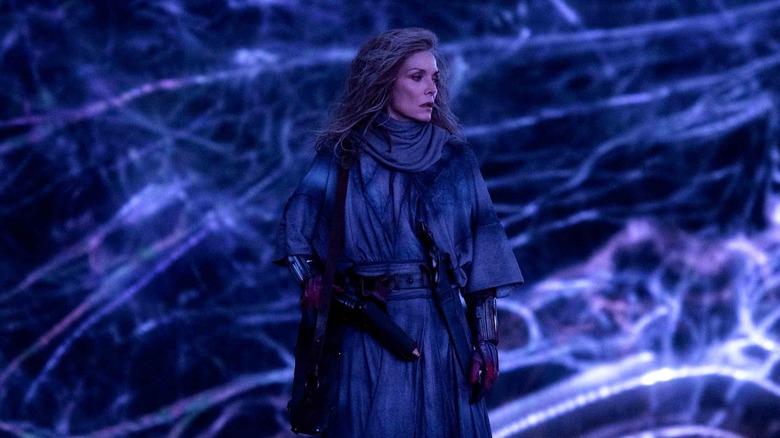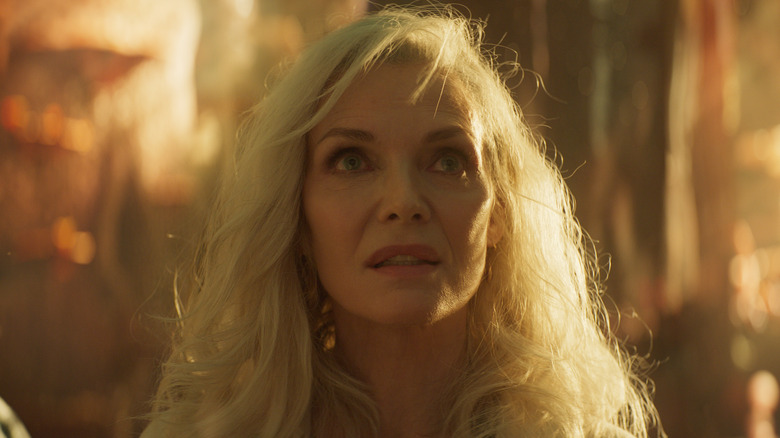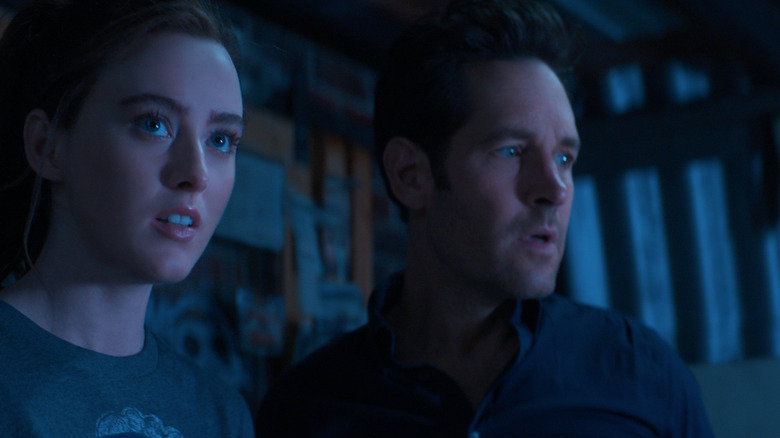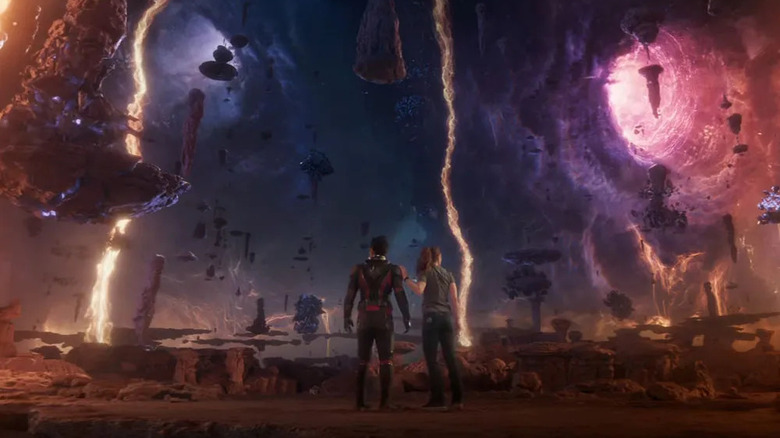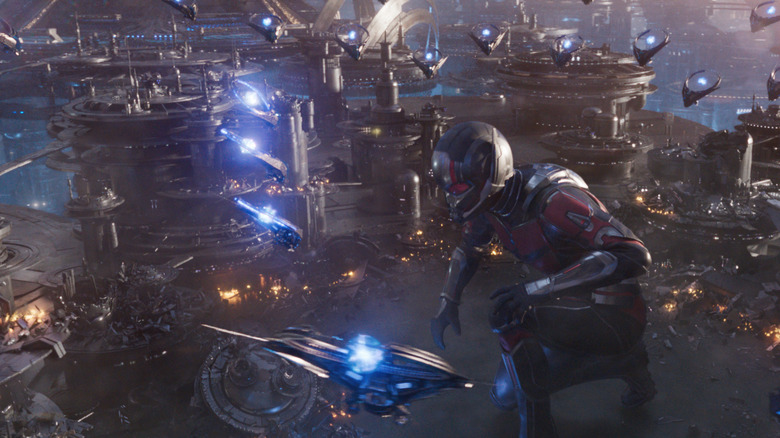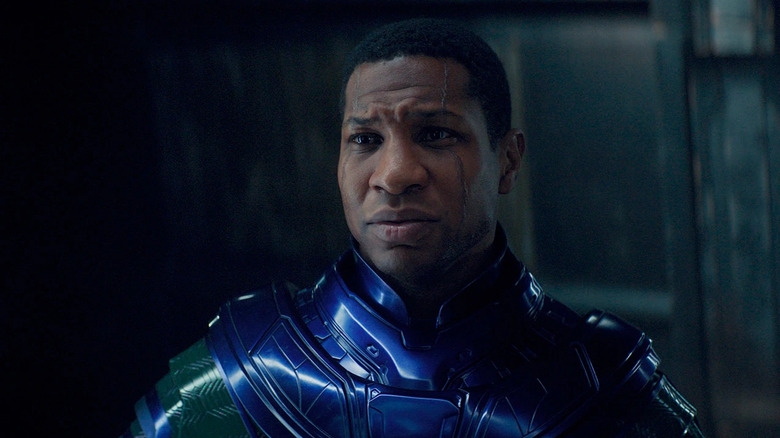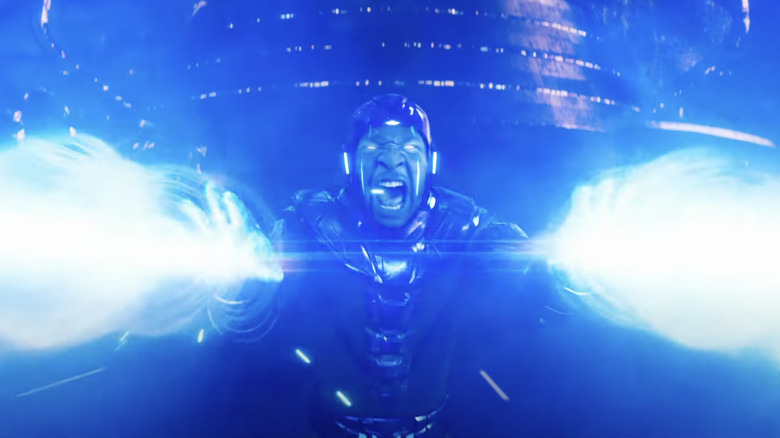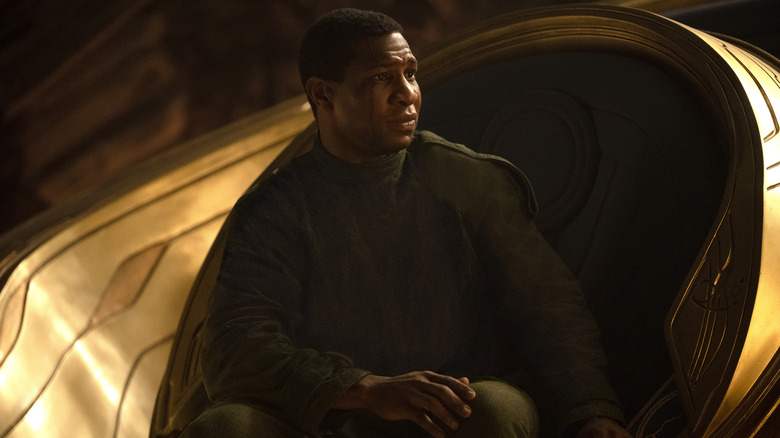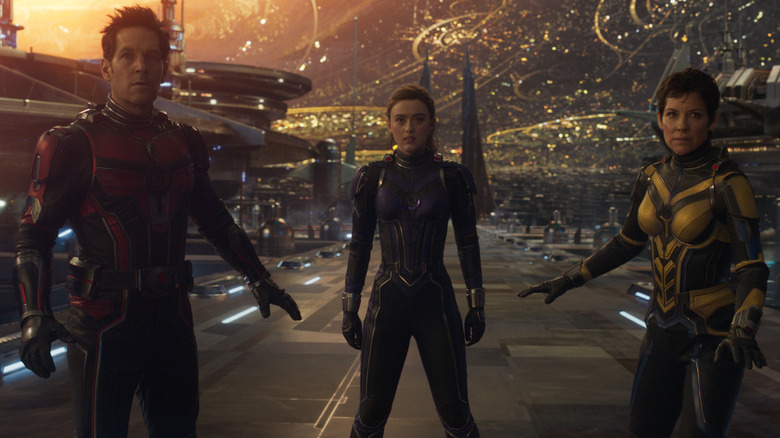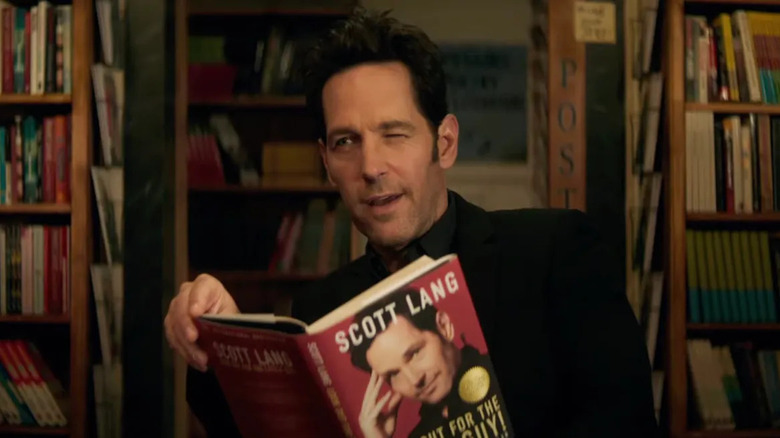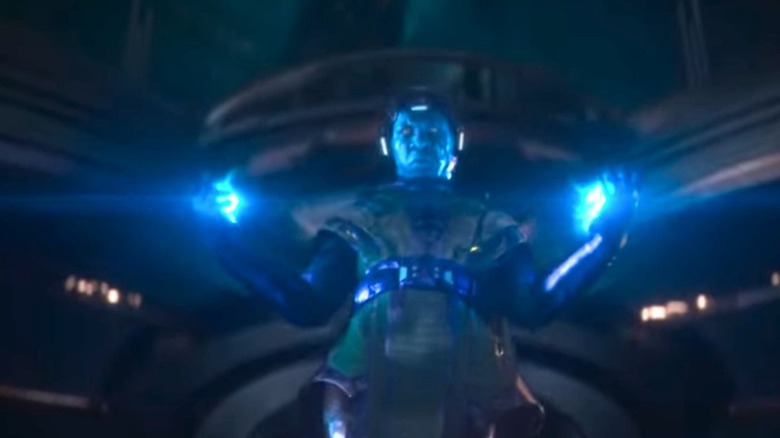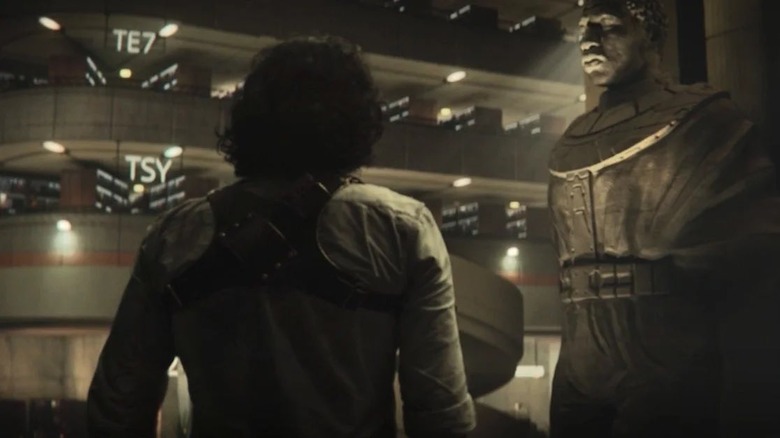Confusing Moments In Ant-Man And The Wasp: Quantumania Explained
With its multiverses, branching timelines, variants, and subatomic realities, the MCU can get a little convoluted. "Ant-Man and the Wasp: Quantumania" — which builds on much of the weird science mumbo jumbo first explored in Phase 4 — might be the most difficult installment to unpack yet.
After Cassie's invention goes kablooey, Scott Lang and his loved ones take an unplanned trip to the Quantum Realm, where they encounter Kang (Jonathan Majors). Despite the fact that Subatomica boasts some breathtaking scenery and some pretty cool bars, everybody wants out. But freeing Kang means potentially unleashing ruin on the multiverse. Ant-Man, the Wasp, Cassie (Kathryn Newton), Hank (Michael Douglas), and Janet (Michelle Pfeiffer) have to fight against Kang on the side of the Quantum Realm's rebels before they can return home to San Francisco, where they'll celebrate Cassie's birthday with some disgusting, mis-spelled ice cream cake.
There are callbacks to important events from prior films, as well as references to the comics that inspired "Quantumania" and other Marvel Studios projects on the horizon, some of which might require some explaining to viewers who aren't completely caught up on every movie and TV show. But this movie in particular isn't confusing because it's too complicated. The problem is, some of the pivotal plot points are glossed over and others are so thinly thought out, they feel like plot holes. From iffy tech to infinite Kangs, these are the (spoiler-heavy) questions audiences may have been asking themselves as they watched "Ant-Man and the Wasp: Quantumania."
When does it take place?
"Quantumania" kicks off with a brief flashback that takes place in the Quantum Realm. Janet is hiding out for her own safety in what she later calls Subatomica. She sees a ship crash in the distance and on her way to approach it, she deftly fends off some dangerous-looking creatures. But this isn't Hank's voyage to fetch her from the hidden universe in "Ant-Man and the Wasp," which led to their reunion. Instead, moments later, a distraught Kang reaches out for help.
A refresher: Janet got trapped in the Quantum Realm in approximately 1987, when she turned off her regulator and went subatomic to stop a missile from killing thousands. She put an antennae in Scott's head during his momentary visit to the Quantum Realm in 2015 and was rescued by Hank in 2018, meaning she spent about 31 years there.
While the present timeline within "Quantumania," in which Cassie's device sucks the Pyms and Langs into the subatomic universe, takes place in 2025, this flashback takes place sometime between 1987 and 2018... probably much closer to her arrival than her departure. After their falling out, Kang had time to conquer the native population and build his citadel, but then again, time works a little differently for him, so who knows how long that would take? Generally speaking, the film's main action runs concurrent to most of Phase 4, starting with "Moon Knight," which is also set in 2025.
Who was blipped?
Throughout the film, Cassie alludes to the fact that she's had to take care of herself — and has gotten pretty good at it. This isn't a reference to Scott's years in the slammer or his days under house arrest. When Thanos snapped his fingers and wiped half of the population out of existence, it had a profound impact on Cassie's upbringing. In the mid-credits stinger of "Ant-Man and the Wasp," viewers saw that Hank, Janet, and Hope all disappeared into dust as they were experimenting with a small, mobile version of their quantum tunnel. Scott had just traveled back to the Quantum Realm via that tunnel to gather particles in an effort to heal Ghost/Ava (Hannah John-Kamen).
Scott wasn't blipped, but he might as well have been. He couldn't come back from the subatomic world without the help of Hank, Janet, and Hope manning the machine on the other side. Nobody even knew he was down there, and he only re-emerged (and the Avengers were only able to undo Thanos' snap) because a rat inadvertently activated Hank's machine.
Regardless, Cassie was without a father for five years. It's also possible she was without a mother and step-father. Maggie and Jim don't appear in "Avengers: Endgame," and there's a fan theory that the blip is the reason why. They aren't in "Quantumania" either, and Cassie's bitterness over having had to fend for herself suggests the fan theory might be true.
What does Cassie's invention do?
The Marvel Cinematic Universe has never taken great pains to explain the way science (or sometimes magic or religion) works in its version of our world. The time heist in "Avengers: Endgame" is just one example; the whole plot goes down smoother if the audience doesn't think too much about it. The goal isn't to teach the audience how to travel through time and space, it's to make something like Hank Pym's technology seem plausible by using science jargon and creating comparisons to tech that already exists here and now, on Earth. That's what "Quantumania" does with Cassie's invention.
To Scott and Janet's dismay, Hank and Hope have been encouraging the budding lawbreaker/engineer to tinker around the lab. She's been working on what Hank calls a subatomic Hubble telescope in the basement. It's basically a satellite that compiles signals from the Quantum Realm into data that can be read as a 3D map. Trying to take pictures of a hidden universe is one thing, but communicating is another, and Janet realizes that someone (like Kang or, as it turns out, M.O.D.O.K.) could be intercepting or even responding to Cassie's signals.
That's exactly what happens in the inciting incident of "Quantumania." Sure, it seems like if abandoned teenage Cassie would've been able to fashion such a device, Hank probably would've been able to as well, to ascertain Janet's whereabouts. But the invention's true purpose isn't to map the mini-universe; it's to get the main characters from point A to point B in the story.
How does Pym tech work in the Quantum Realm?
The act of going subatomic looms as a threat in the first and second "Ant-Man" movies, the reason being the super suits and the Pym tech they rely upon aren't able to return the wearer to their normal size after a certain point.
The horrifying concept of Janet going subatomic in "Ant-Man" flashbacks was derived from the notion of her getting infinitely smaller and smaller without any means of control. Franchise fans know that Hank and Hope made advancements to their research and improvements to their suits between 2015's "Ant-Man" and 2018's "Ant-Man and the Wasp," and it can be assumed they've continued to refine their suits into 2025. Still, it's odd that once in the Quantum Realm, Pym tech functions exactly as its supposed to on Earth's surface.
The Quantum Realm is still a pretty perilous place to be, but not because of the limitations of Hank's gear. Scott, Hope, and Cassie all use their suits to shrink and grow at will in "Quantumania," and characters use Hank's throwable discs to make various objects larger and smaller, too (this is the same technique Scott tries on himself to escape the Quantum Realm the first time). It's funny to think that when Ant-Man's the size of a Kaiju in his fight against Kang, he's actually only a handful of subatomic particles tall. But why doesn't getting bigger propel anyone from the Quantum Realm this time? Is it possible to go sub-subatomic, and would that be just as dangerous? The real answer is that Marvel Studios wanted Ant-Man to retain his trademark superpower in this fantastical new setting.
Which Kang is this?
If you take He Who Remains at his word, he was the Kang who defeated his counterparts to so that he could restore order to the timeline. That Kang warned Sylvie and Loki that if they struck him down, the power vacuum caused by his death would be filled by a plethora of Kangs even more villainous. So, why are there so many Kang variants in the first place, and why are they all so formidable?
Loki's Kang explained it this way: he was once a scientist (Nathaniel Richards, from an alternate 31st century) who discovered the multiverse. The other universes' Kang variants were making the same discovery at the same time. At first, this led only to self-congratulation, but it wasn't long before some Kangs showed their true colors; the multiverse erupted into Kangs at war with one another.
As far as anyone knows, He Who Remains is no more. But before he was dispatched, he told Loki and Sylvie of a "conqueror," which is the same word Jentorra and Janet use to describe the Kang stuck in the Quantum Realm — this is long before he ever shouts out his own name. Kang the Conqueror is one of the character's most iconic forms in the comics. "Ant-Man and the Wasp: Quantumania" nails his facial markings (which are depicted as scars), as well as his blue face shield as unsettling, calm-until-he's-not authoritarian demeanor. While it remains unknown if this Kang is Prime Kang (there's a Prime Kang in the comics), it's clear that he's bad news.
Who exiled him?
There aren't many beings in the multiverse capable of contending with Kang. As he nonchalantly brags to Ant-Man, he's made short work of the Avengers before. Janet realizes that he's not some poor stranded voyager but a banished despot when she makes contact with the energy core bound to his mind, which powers his ship. She has a vision of interdimensional cosmic chaos caused by Kang in which whole timelines and universes were destroyed so that he could stay in power. Presumably, he was exiled for exactly this. But who decided and enforced his sentence?
Kang the Conqueror alludes to the fact that others like him are responsible for his predicament. But he doesn't see himself as a villain. Not unlike He Who Remains (or Thanos, for that matter), this Kang thinks his indiscriminately cruel rule is necessary for the survival of the multiverse itself, and he tries to convinces Scott that he's the lesser of two (or in this case, infinite) evils. Years earlier, Janet didn't believe him and stopped cooperating with his efforts to escape immediately. The rebels, led by Jentorra (Katy M. O'Brian) and Quaz (William Jackson Harper), would agree. They describe a Kang who lays waste to every civilization that stands in his way, which supports the idea that other, more benevolent Kangs sent the Conqueror to the practically inescapable Quantum Realm to try to contain this most monstrous variant.
Why can't he leave?
The Quantum Realm is practically inescapable — as opposed to actually inescapable, because audiences have seen three characters (Scott, Hank, and Janet) get in and out before.
Kang is elated when Scott (who's managed to flee Subatomica twice now) pops up with his daughter Cassie. This gives Kang a way to restart his ship, as well as something to hang over Scott's head so he'll go through with it. After Janet blew it up years ago, Kang needs Scott to shrink his energy core back down to size so that it'll fit into the reactor again. If he refuses, Kang will kill Cassie. It makes emotional sense to put Scott and Cassie in this position, but that Kang would really need their help strains belief, especially for those who are familiar with the character's backstory.
Nathaniel Richards (Kang's human form) comes from an alternate 31st century in which there never were Dark Ages that halted scientific and cultural progress. Even before he became Kang and thereby privy to everything that happens throughout all time, he still possessed vast, in-depth knowledge that would've been unimaginable in 21st century America on Earth-616. It stands to reason that, as brilliant as Hank Pym is, his tech couldn't hold a candle to whatever Nathaniel would've been working on.
If Scott was able bust out of the Quantum Realm with one of Hank's discs and Cassie was able to invent a way to communicate and map the hidden universe, it seems highly unlikely that a being as smart and powerful as Kang wouldn't have been able to solve this problem on his own.
Is Cassie a superhero now?
The MCU has been welcoming a series of fresh female faces to its roster as of late, beginning with Yelena Belova (Florence Pugh) in "Black Widow," and continuing with Kate Bishop (Hailee Steinfeld), America Chavez (Xochitl Gomez), Kamala Khan (Iman Vellani), and Riri Williams (Dominique Thorn). Age-wise, Cassie Lang (as portrayed by Kathryn Newton in "Quantumania") fits in with the direction the MCU seems to be going. Some fans even wondered if the third "Ant-Man" movie might see the launch of the Young Avengers. That didn't happen, but Cassie Lang could still join their ranks at some point in the future. She's got the suit, if not the name... yet.
In the comics, Cassie's superhero alter ego goes by the names Stinger and Stature. Stinger is more in keeping with Ant-Man and the Wasp, but she's in Stature mode when she goes gigantic along with her dad (curiously, the sensation makes her hungry for limes). Early promotion of a Hasbro Cassie Lang toy accidentally spoiled that plot point in the movie, though nobody uses that word in the script. Cassie's purplish-blue costume is a hybrid of her Stinger and Stature looks. Designers have also given her super Converse instead of boots. Since any MCU projects Newton may be involved in down the line are still in development or pre-production, it's probably best to think of Cassie as a superhero-in-training.
Did Scott save the world?
"Quantumania" concludes as Scott takes stock of his almost too-good-to-be-true life. Then, he remembers something Kang said. If he didn't break free from the Quantum Realm, life as he knows it could cease to exist. Suddenly, Scott finds himself wondering if he did the right thing by conquering the Conqueror. The film cuts to black, and whether the world was saved or doomed is left an open question. This depends on which (if any) Kangs you choose to trust. So far, He Who Remains seems to have been telling the truth in "Loki" Season 1, Episode 6. When he fell, the timeline did branch, and more Kangs became part of the Marvel Cinematic Universe.
No one knows if Kang the Conqueror was being honest when he elicited Scott's help, or if his warped point of view was merely justification for his horrendous actions. It is also unknown if he's truly dead. It looked like he met his end in his final showdown against Ant-Man and the Wasp, when more of those disks either disintegrated him or sucked him into a void, similar to Yellowjacket's fate in the first "Ant-Man."
The first post-credits scene makes it seem as though news has spread of Kang the Conqueror's demise. But what impact Scott and Hope's actions will have on the rest of the MCU remain to be seen. There could be worse Kangs than the conqueror out there scheming to obliterate universes — or Scott, Hope, and Cassie might become the sole targets of a Kang's (or myriad Kangs') wrath.
What's the Council of Kangs?
The primary thing that die-hard Kang fans want to see in "Quantumania" doesn't happen until after the film is over.
In the first post-credits scene, an arena full of Kang variants has gathered. This is the Council of Kangs, a mind-bending arc from Avengers #267-269 in which the multiverse's permutations of Kang convene, led by Prime Kang, with the stated purpose of pruning problem variants from existence. There's a twist — which is best left unsaid in case the MCU keeps borrowing from this source material — but another version of the council appears in another comics run, a panel of which is recreated in the mid-credits stinger's final shot.
Three Kangs get more attention than the others, and the identity of two of them seems clear. Since Kang has the power to traverse time and multiverses, this otherwise normal flesh-and-blood human likes to mix things up by, say, becoming an Egyptian Pharaoh for awhile or occupying Limbo and ordering around the Time Keepers. One of these Kangs is Rama-Tut, a variant who sent himself back to 2960 B.C. and used his boundless knowledge to rule over ancient Egypt, eventually turning himself into a god-like figure and a super villain who butts heads with Khonshu from "Moon Knight." Another is Immortus, a powerful futuristic variant. A third figure doesn't bear as obvious a resemblance to Kang's comic book appearances. He could be Scarlett Centurion or Iron Lad, a composite of such Kang characters, or a totally new variant created for the MCU. A final title card promises that Kang will return. Expect to see more of him in Phases 5 and 6, leading up to "Avengers: The Kang Dynasty."
Which Kang did Mobius and Loki find?
Kang is poised to become the primary antagonist of the Marvel Cinematic Universe after "Quantumania," but he made his debut on TV. So, it seems only appropriate that a "Quantumania" end-credits scene brings a Kang back into Loki's orbit, setting up a likely plotline for his returning Disney+ show.
A man, not-so-coincidentally played by Jonathan Majors, is on a small stage presenting a contraption to an audience. Judging from the clothes, the hairstyles, and the decor, this all takes place around the turn of the century. Loki turns to show his face to the camera, followed shortly thereafter by Mobius. It's clear that they've been on the trail of this Kang for a while, though Mobius doesn't understand why the unassuming gentleman on stage is such a big deal.
This variant goes by the name Victor Timely. He's a disguised Kang, who travels to a small town in Wisconsin in 1901 and uses his genius and inventions to wow the locals. Eventually, he becomes mayor and sows the seeds for a broader and more permanent takeover. Victor Timely could very well be the villain of "Loki" Season 2, or perhaps the God of Mischief-turned-TVA agent and his partner may be in pursuit of multiple Kangs, of which Timely is merely one. Either way, it seems likely that the series will pick up where this teaser leaves off when it premieres later this year.
